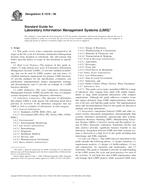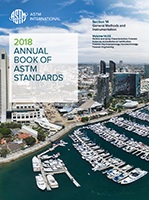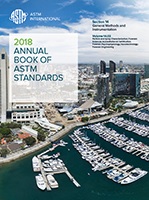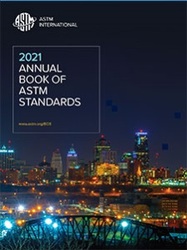Original price was: $83.00.$49.80Current price is: $49.80.
Standard Guide for Laboratory Information Management Systems (LIMS)
standard by ASTM International, 09/01/2006
Description
1.1 This guide covers issues commonly encountered at all stages in the life cycle of Laboratory Information Management Systems from inception to retirement. The sub-sections that follow describe details of scope of this document in specific areas.
1.2 High Level PurposeThe purpose of this guide includes: (1) help educate new users of Laboratory Information Management Systems (LIMS), (2) provide standard terminology that can be used by LIMS vendors and end users, (3) establish minimum requirements for primary LIMS functions, (4) provide guidance for the specification, evaluation, cost justification, implementation, project management, training, and documentation, and (5) provide an example of a LIMS function checklist.
1.3 LIMS DefinitionThe term Laboratory Information Management Systems (LIMS) describes the class of computer systems designed to manage laboratory information.
1.4 Laboratory CategoriesThe spectrum of laboratories that employ LIMS is wide spread. The following break down provides an overview of the laboratory categories that use LIMS as well as examples of laboratories in each category.
1.4.1 General Laboratories
Standards (ASTM, IEEE, ISO), and
Government (EPA, FDA, JPL, NASA, NRC, USDA, FERC).
1.4.2 Environmental
Environmental Monitoring.
1.4.3 Life Science Laboratories
Biotechnology,
Diagnostic,
Healthcare Medical,
Devices, and
Pharmaceuticals Vet/Animal.
1.4.4 Heavy Industry Laboratories
Energy Resources,
Manufacturing Construction,
Materials Chemicals, and
Transportation Shipping.
1.4.5 Food Beverage Laboratories
Agriculture,
Beverages,
Food, and
Food Service Hospitality.
1.4.6 Public Sector Laboratories
Law Enforcement,
State Local Government,
Education, and
Public Utilities (Water, Electric, Waste Treatment).
1.4.7 Laboratory Size
This guide covers topics regarding LIMS for a range of laboratory sizes ranging from small with simple requirements to large multi-site/global laboratories with complex requirements. Although the guide addresses complex issues that impact primarily large LIMS implementations, laboratories of all sizes will find this guide useful. The implementation times and recommendations listed in this guide are directed at medium and large laboratories.
1.5 IntegrationIntegration between LIMS and other external systems (document management, chromatography data systems, laboratory instruments, spectroscopic data systems, Enterprise Resource Planning (ERP), Manufacturing Execution Systems (MES), Corrective Action and Preventative Action (CAPA), Electronic Laboratory Notebooks (ELNs) and data archive) provides significant business benefits to any laboratory. Integration between LIMS and other external systems is discussed at a high level in this guide including data interchange and XML standards.
1.6 Lifecycle PhasesThe LIMS lifecycle described in this guide includes the following phases: (1) project initiation, (2) requirements analysis, (3) design, (4) build/configure, (5) test and commission, (6) operation and maintenance, and (7) retirement. This guide is intended to provide an understanding of the LIMS system life cycle and good practices for each of the activities. It will help first time LIMS implementers plan and manage their LIMS projects while seasoned LIMS users may use the LIMS system life cycle to maintain existing LIMS and prepare for the implementation of the next generation LIMS.
1.7 AudienceThis guide has been created with the needs of the following stakeholders in mind: (1) end users of LIMS, (2) implementers of LIMS, (3) quality personnel, (4) information technology personnel, (5) LIMS vendors, (6) instrument vendors, (7) individuals who must approve LIMS funding, (8) LIMS application support specialists, and (9) software test/validation specialist. Information contained in this guide will benefit a broad audience of people who work or interact with a laboratory. New LIMS users can use this guide to understand the purpose and functions of LIMS. The guide can also help prospective LIMS users in understanding terminology, configurations, features, design, benefits and costs. Individuals who are purchasing a LIMS may use this guide to identify functions that are recommended for specific laboratory environments. Research and Development staff of commercial LIMS vendors may use the guide as a tool to evaluate, identify, and potentially improve the capabilities of their products. LIMS vendor sales staff may use the guide to represent functions of their LIMS product to prospective customers in more generic and product neutral terms.
1.8 Out of ScopeThe full description and use of systems mentioned in this guide within the context of interfaces to LIMS are beyond the scope of this standard. Examples of these systems include Chromatography Data Systems (CDS), Electronic Laboratory Notebooks (ELN), Data Archive, Scientific Data Management Systems (SDMS), Enterprise Resource Planning (ERP), Manufacturing Execution Systems (MES) and Electronic Document Management Systems (EDMS).
Product Details
- Published:
- 09/01/2006
- Number of Pages:
- 39
- File Size:
- 1 file , 920 KB
- Redline File Size:
- 2 files , 1.9 MB
- Note:
- This product is unavailable in Russia, Ukraine, Belarus





